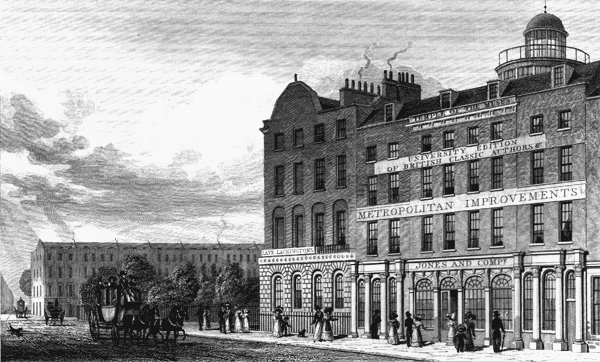The Temple of Muses

The Temple of Muses–jaw dropping bookseller of Jane Austen’s time.
The Temple of Muses
Billed as the “Cheapest Bookseller in the World,” the Temple of Muses enjoyed a reputation as being one of the biggest booksellers of the day. Run by Lackington Allen & Company at No. 32, Finsbury Place South, in Finsbury square from 1778-1798, the book store would publish catalogs ranging from twelve thousand to over thirty thousand titles. (Kind of makes the bookworm in me drool—just saying.)
The shop frontage was one hundred and forty feet long, making it one of the tourist sites to see in London. The middle of the shop posted an enormous circular counter, large enough that it was said that a mail coach and four (or six, depending upon the account) could be driven around it. A wide staircase led to ‘lounging rooms’ and galleries of bookshelves, which were rather unusual in the day. Usually booksellers kept their wares solely behind the counter where only the clerks had access. As patrons climbed to higher floors, the books become “shabbier”—as used books often are—but cheaper.
What set Lackington apart
James Lackington believed books were the key to knowledge, reason and happiness. Moreover, he suggested that everyone, regardless of economic background, social class or gender, had the right to access affordable books. The way he ran his store certainly supported these beliefs.

His business practices were as unique as his storefront. He pioneered what is known in the book trade as ‘remaindering’. Lackington would buy up the unsold volumes of print runs from publishers (that would otherwise have been destroyed) at rock bottom prices, allowing him to sell them to his customers at bargain prices. He also bought up entire libraries and even published some author manuscripts. Unlike most other businesses of the era, he refused to extend credit, insisting on cash only transactions. While this did bring him some notoriety, it also allowed him to continue to offer excellent prices and turn hefty profits.
Born in 1746, Lackington was a traveling pieman at ten and an apprentice shoemaker at fourteen. When he left for London after his first marriage, he had half a crown (12.5p) to his name. Once in London, he soon set up a combined bookstall and shoemaker’s shop on Featherstone Street. Stocked with a sack of old theological books for which he paid a guinea, and some scraps of leather he plied both trades.
With a loan of £5, continued hard work and his wife’s thrift, he was finally able to build up enough stock in books that he was able to give up shoemaking and devote himself completely to the book trade. (Goodman, 2004) By 1792, the profits on his book store were estimated between £4000 and £5000 per year, selling upwards of one hundred thousand volumes a year. A far cry from his humble beginnings as the son of a shoemaker.
Find References HERE
Find the Regency Life Index HERE
Read more about Regency era Amusements HERE.
Read more about libraries HERE.
If you’d like to read more about Regency era history, you might like these:

Fascinating!!! My first job was as a bookstore clerk at the old B. Dalton Booksellers back in the early ’80s. I worked at a couple of stores throughout high school and college. Then after college, armed with a BA in Literature, I couldn’t find a job to save my life. Fortunately, my first B. Dalton manager was now managing the Harcourt Brace bookstore in the basement of the publishing house, the only major publisher on the west coast. Dennis hired me on the spot (for the third time, actually), and I worked there before, during, and after graduate school while I waited for an adjunct opening at my former college. Working as a bookseller on and off for a decade made me love books all the more!
I loved the history of this most unusual of bookshops!! My husband would not allow me to step foot in any bookshops on our trip to Britain in ’88; he knew I’d end up sending boxes of books home, and my bookcases were already groaning! (And I have to admit that 21 years of homeschooling has NOT improved the situation, LOL!)
Warmly,
Susanne 🙂
You definitely have to watch out for a bookworm in a bookshop. It’s a dangerous combination.
Wow, would’t Lizzy love to see this place? I bet Lackington or his associates also went to estate sales and bought the books in those libraries. He might even have patrons that he bought books for… such as… Mr. Darcy [senior]. Perhaps he was in correspondence with a certain Mr. Bennet of Longbourn and purchased books for him. Or was at least on the lookout for books for both gentlemen. Too bad the timing is off [1778 – 1798] for our Lizzy or Darcy. Their appearance would be as very young children. It would still make an impression.
That would be a fun scene to write, either of them as children at that bookshop. Hmmm…